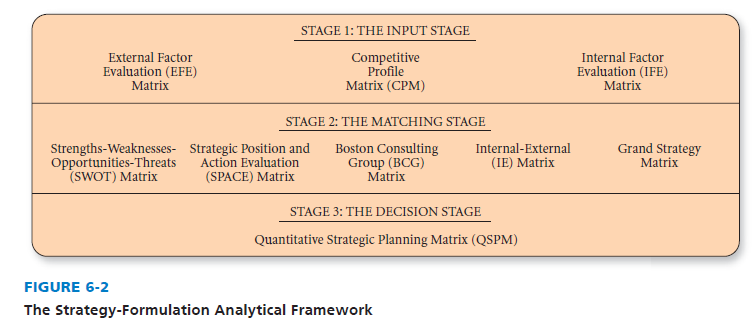Important strategy-formulation techniques can be integrated into a three-stage decision-making framework, as shown in Figure 6-2. The tools presented in this framework are applicable to all sizes and types of organizations and can help strategists identify, evaluate, and select strategies.
Stage 1 of the strategy-formulation analytical framework consists of the External Factor Evaluation (EFE) Matrix, the Internal Factor Evaluation (IFE) Matrix, and the Competitive Profile Matrix (CPM). Called the input stage, Stage 1 summarizes the basic input information needed to formulate strategies. Stage 2, called the matching stage, focuses on generating feasible alternative strategies by aligning key external and internal factors. Stage 2 techniques include the Strengths-Weaknesses-Opportunities-Threats (SWOT) Matrix, the Strategic Position and Action Evaluation (SPACE) Matrix, the Boston Consulting Group (BCG) Matrix, the Internal-External (IE) Matrix, and the Grand Strategy Matrix. Stage 3, called the decision stage, involves a single technique, the Quantitative Strategic Planning Matrix (QSPM). A QSPM uses input information from Stage 1 to objectively evaluate feasible alternative strategies identified in Stage 2. It reveals the relative attractiveness of alternative strategies and thus provides an objective basis for selecting specific strategies. The QSPM is a more robust way to determine the relative attractiveness of strategies than the 1) summed ranking method described above, or the 2) individual vs group ranking method described on pages 366-367 in Part 6).
All nine techniques included in the strategy-formulation analytical framework require the integration of intuition and analysis. Autonomous divisions in an organization commonly use strategy-formulation techniques to develop strategies and objectives. Divisional analyses provide a basis for identifying, evaluating, and selecting among alternative corporate-level strategies.
Strategists themselves, not analytic tools, are always responsible and accountable for strategic decisions. Lenz emphasized that the shift from a words-oriented to a numbers-oriented planning process can give rise to a false sense of certainty; it can reduce dialogue, discussion, and argument as a means for exploring understandings, testing assumptions, and fostering organizational learning.1 Strategists, therefore, must be wary of this possibility and use analytical tools to facilitate, rather than to diminish, communication. Without objective information and analysis, personal biases, politics, prejudices, emotions, personalities, and halo error (the tendency to put too much weight on a single factor) oftentimes play a dominant role in the strategy-formulation process, undermining effectiveness. Thus, an analytical approach is essential for achieving maximum effectiveness in strategic planning.

1. The Input Stage
Procedures for developing an EFE Matrix, an IFE Matrix, and a CPM were presented in Chapters 3 and 4. Information derived from the EFE Matrix, IFE Matrix, and CPM provides basic input information for the matching and decision stage matrices described in this chapter.
The input tools require strategists to quantify subjectivity during early stages of the strategy- formulation process. Making small decisions in the input matrices regarding the relative importance of external and internal factors allows strategists to more effectively generate, prioritize, evaluate, and select among alternative strategies. Good intuitive judgment is always needed in determining appropriate weights and ratings, but keep in mind that a rating of 3, for example, is mathematically 50 percent more important than with a rating of 2, so small differences matter.
2. The Matching Stage
Strategy is sometimes defined as the match an organization makes between its internal resources and skills and the opportunities and risks created by its external factors.2 The matching stage of the strategy-formulation framework consists of five techniques that can be used in any sequence: the SWOT Matrix, the SPACE Matrix, the BCG Matrix, the IE Matrix, and the Grand Strategy Matrix. These tools rely on information derived from the input stage to match external opportunities and threats with internal strengths and weaknesses. Matching external and internal key factors is the essential for effectively generating feasible alternative strategies. For example, a firm with excess working capital (an internal strength) coul
Source: David Fred, David Forest (2016), Strategic Management: A Competitive Advantage Approach, Concepts and Cases, Pearson (16th Edition).d take advantage of the cell phone industry’s 20 percent annual growth rate (an external opportunity) by acquiring Cellfone, Inc. This example portrays simple one-to-one matching. In most situations, external and internal relationships are more complex, and the matching requires multiple alignments for each strategy generated. Successful matching of key external and internal factors depends on those underlying key factors being specific, actionable, and divisional to the extent possible. The basic concept of matching is illustrated in Table 6-1.
3. The Decision Stage
As indicated above, participants could individually rate strategies on a 1-to-4 scale as to desirability, and then sum the ratings from all participants, so that a prioritized list of the best strategies could be achieved. However, the QSPM, described later in this chapter, offers a more robust procedure to determine the relative attractiveness of alternative strategies.
Source: David Fred, David Forest (2016), Strategic Management: A Competitive Advantage Approach, Concepts and Cases, Pearson (16th Edition).

Hey there, I think your website might be having browser compatibility
issues. When I look at your website in Ie, it looks fine but when opening in Internet Explorer, it
has some overlapping. I just wanted to give you a quick
heads up! Other then that, very good blog!
I am sure this piece of writing has touched all the
internet people, its really really pleasant piece of writing on building up new blog.
Valuable information. Lucky me I discovered your web site accidentally, and I am surprised why this coincidence did not took place
earlier! I bookmarked it.
This paragraph is genuinely a pleasant one it assists new the web
viewers, who are wishing for blogging.
Thanks on your marvelous posting! I quite enjoyed reading it, you are a great author.
I will be sure to bookmark your blog and will come back later on. I want to
encourage that you continue your great posts, have a nice holiday weekend!
Utterly composed content, Really enjoyed reading through.
I well understand it. I can help with the question decision. Together we can find the decision.